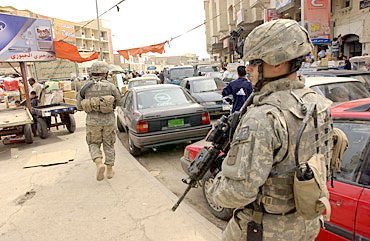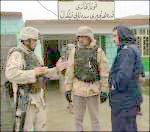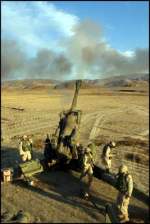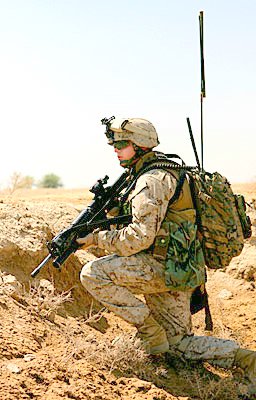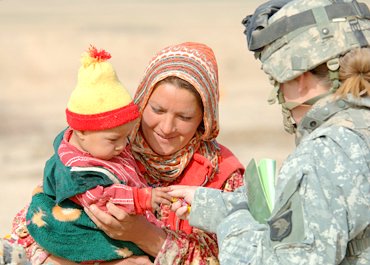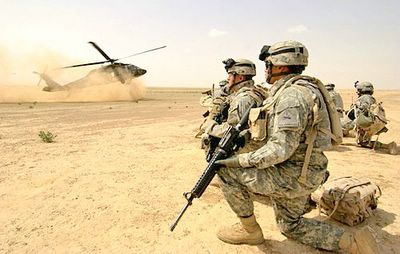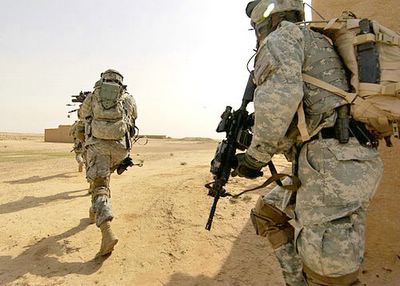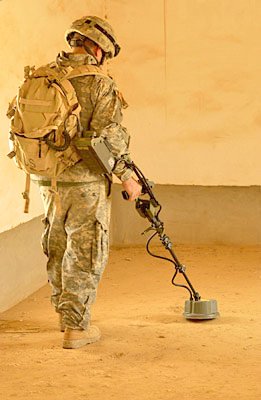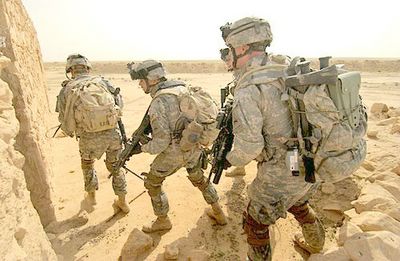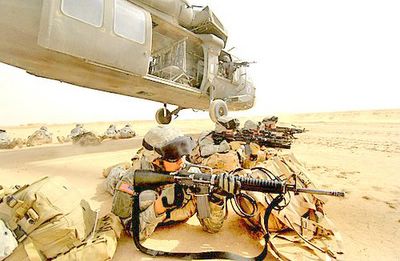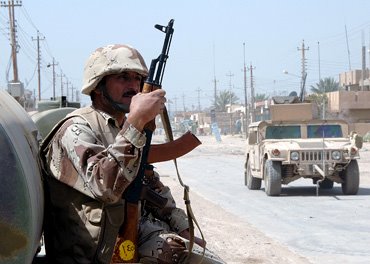Friday, March 31, 2006
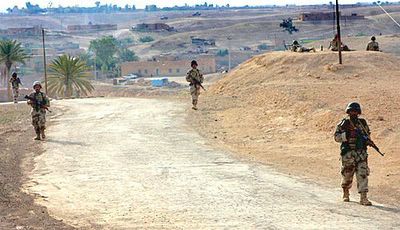
Iraqi soldiers with 2nd Battalion, 2nd Brigade, 7th Iraqi Army Division patrol a street in Khaffajiah, Iraq, March 14, 2006. More than 100 soldiers from the Iraqi Army�s 2nd Battalion, 2nd Brigade, 7th Iraqi Army Division conducted their first independently-executed mission to disrupt insurgent operations during Operation Raging Bull. U.S. Marine Corps photo by Cpl. Adam C. Schnell

An Iraqi army soldier with 2nd Battalion, 2nd Brigade, 7th Iraqi Army Division mans his machine gun as fellow soldiers participate in the region's first Iraqi-led mission to clear Khaffajiah, Iraq, of insurgents and weapons caches during Operation Raging Bull, March 14, 2006. U.S. Marine Corps photo by Cpl. Adam C. Schnell

U.S. Marine Corps Cpl. Ralph E. Arzate, a squad leader with Company L, 3rd Battalion, 1st Marine Regiment, takes a knee while on patrol during Operation Raging Bull in Albu Hayatt, Iraq, March 12, 2006. The Marines and Iraqi Army soldiers cleared Albu Hayatt, a village just south of Haqlaniyah, Iraq, along the Euphrates River, and maintained a four-day presence in the area to disrupt insurgent activity. U.S. Marine Corps photo by Cpl. Adam C. Schnell

Iraqi soldiers with 2nd Battalion, 2nd Brigade, 7th Iraqi Army Division, rush into a courtyard to search for weapons and ammunition caches and insurgent activity during a counterinsurgency operation in Khaffajiah, Iraq, March 14, 2006. The Iraqi-led operation, which is part of a larger, on-going, Coalition-led counterinsurgency operation dubbed Operation Raging Bull, was the first, fully-independent Iraqi Army-led mission in the "Triad" region of Haditha, Haqliniyah, and Barwanah off the Euphrates River in western Al Anbar Province, Iraq. U.S. Marine Corps photo by Cpl. Michael R. McMaugh

A village elder shakes hands with U.S. Marine Corps Staff Sgt. James Robertson during a visit by members of the 1st Battalion, 3rd Marine Regiment to Rechah Lam, Afghanistan, March 11, 2006. Robertson is a section leader with the battalion�s Combined Anti-Armor Team. U.S. Marine Corps photo by Sgt. Joe Lindsay

U.S. Marine Corps Staff Sgt. Andrew Giermann takes an Afghan boy�s hand during a recent visit to Rechah Lam, a village in Kunar Province, Afghanistan, March 11, 2006. Giermann, of the Scout Sniper Platoon of the 1st Battalion, 3rd Marine Regiment, joined other Marines in distributing food, blankets, clothing and toys. U.S. Marine Corps photo by Sgt. Joe Lindsay

With siblings in tow, an Afghan girl flashes a smile after receiving toys and clothes from U.S. Marines of the 1st Battalion of the 3rd Marine Regiment in Rechah Lam, in Kunar Province, Afghanistan, March 11, 2006. The Marines visited Rechah Lam to show their support to the villagers, who have been threatened by insurgents. U.S. Marine Corps photo by Sgt. Joe Lindsay

Goats keep pace with humvees from the 1st Battalion, 3rd Marine Regiment, as U.S. Marine Corps Lance Cpl. Matthew Smith, a machine gunner with the battalion�s Combined Anti-Armor Team 2, keeps a watchful eye for insurgents as the Marines enter the hamlet of Rechah Lam in Kunar Province in eastern Afghanistan, March 11, 2006. U.S. Marine Corps photo by Sgt. Joe Lindsay
Thursday, March 30, 2006

U.S. Army Master Sgt. Nardo Dedicatoria keeps an eye on the shoreline of the Euphrates River during a reconnaissance mission near Musayyib, Iraq, on March 21, 2006. Coalition soldiers are not only patrolling the streets of Iraq, but the waterways as well. Dedicatoria is attached to Echo Company, 1st Battalion, 67th Armored Regiment. DoD photo by Petty Officer 2nd Class Katrina Beeler, U.S. Navy. (Released)
Terrorist Cell Leader Captured; Soldiers Destroy Weapons CachesAmerican Forces Press Service
WASHINGTON, March 30, 2006 – Iraqi and U.S. soldiers captured a terrorist cell leader, and more weapons caches have been found and destroyed, military officials reported.
Officials at Forward Operation Base Kalsu said soldiers from 4th Company, 2nd Battalion, 4th Brigade, 8th Iraqi Army Division, conducted the main assault effort to capture the terrorist March 26 in the town of Haswa, about 60 miles south of Baghdad. U.S. soldiers from Company B, 2nd Battalion, 8th Infantry Regiment, 2nd Brigade Combat Team, 4th Infantry Division, provided outer cordon security, officials said.
The suspected cell leader and six others were captured. No damage to personnel, equipment or buildings occurred during the raid, officials said. Elsewhere, soldiers of the 101st Combat Aviation Brigade, Task Force Band of Brothers, found four weapons caches March 28 in Salah Ad Din province, about 80 miles northwest of Baghdad.
Pathfinders -- infantry soldiers specially trained to provide navigational assistance and advisory services to military aircraft -- discovered weaponry and ammunition as they searched several locations in the Sheri Lake area.
The caches contained 20 rockets, 53 rocket-propelled grenades, three anti-aircraft missiles with two launchers, an anti-tank missile, 24 mortar rounds, a mortar tube, and a variety of small-caliber artillery rounds. In addition to the ordnance, soldiers found items commonly used in roadside bombs.
Explosive ordnance disposal personnel destroyed all of the items, officials said.
(Compiled from Multinational Force Iraq news releases
WASHINGTON, March 30, 2006 – Iraqi and U.S. soldiers captured a terrorist cell leader, and more weapons caches have been found and destroyed, military officials reported.
Officials at Forward Operation Base Kalsu said soldiers from 4th Company, 2nd Battalion, 4th Brigade, 8th Iraqi Army Division, conducted the main assault effort to capture the terrorist March 26 in the town of Haswa, about 60 miles south of Baghdad. U.S. soldiers from Company B, 2nd Battalion, 8th Infantry Regiment, 2nd Brigade Combat Team, 4th Infantry Division, provided outer cordon security, officials said.
The suspected cell leader and six others were captured. No damage to personnel, equipment or buildings occurred during the raid, officials said. Elsewhere, soldiers of the 101st Combat Aviation Brigade, Task Force Band of Brothers, found four weapons caches March 28 in Salah Ad Din province, about 80 miles northwest of Baghdad.
Pathfinders -- infantry soldiers specially trained to provide navigational assistance and advisory services to military aircraft -- discovered weaponry and ammunition as they searched several locations in the Sheri Lake area.
The caches contained 20 rockets, 53 rocket-propelled grenades, three anti-aircraft missiles with two launchers, an anti-tank missile, 24 mortar rounds, a mortar tube, and a variety of small-caliber artillery rounds. In addition to the ordnance, soldiers found items commonly used in roadside bombs.
Explosive ordnance disposal personnel destroyed all of the items, officials said.
(Compiled from Multinational Force Iraq news releases
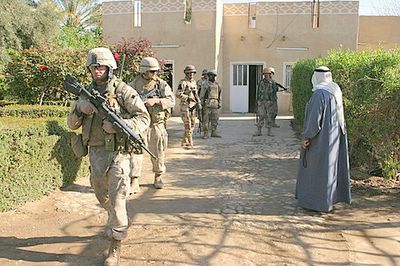
U.S. Marines and Iraqi army soldiers search for weapons in Fallujah, Iraq, March 17, 2006. The Marines are from 3rd Squad, 2nd Platoon, Echo Company, 2nd Battalion, 6th Marine Regiment, Regimental Combat Team 5 and the Iraqi soldiers are from the 2nd Battalion, 4th Brigade, 1st Division. U.S. Marine Corps photo by Cpl. Adaecus G. Brooks

U.S. Army Staff Sgt. Scott McCollum, a dog handler assigned to 2nd Battalion, 22nd Infantry Regiment, 10th Mountain Division, and his dog Rocky stand near ordnance they found during an operation to capture terrorists and ordnance in Oswesat, Iraq, Feb. 19, 2006. U.S. Army photo by Staff Sgt. Kevin L. Moses Sr.
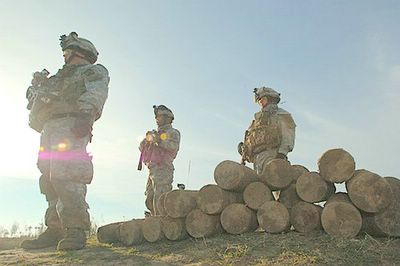
U.S. Army soldiers assigned to 2nd Battalion, 22nd Infantry Regiment, 10th Mountain Division provide security around a weapons cache site discovered during an operation to capture terrorists and ordnance in Oswesat, Iraq, Feb. 19, 2006. The cache had approximately 80 rounds in it. U.S. Army photo by Staff Sgt. Kevin L. Moses Sr.

U.S. Army soldiers assigned to 2nd Battalion, 22nd Infantry Regiment, 10th Mountain Division uncover a weapons cache during an operation to capture terrorists and ordnance in Oswesat, Iraq, Feb. 19, 2006. The cache had approximately 80 105-155mm rounds in it. U.S. Army photo by Staff Sgt. Kevin L. Moses Sr.

A flash of fire and smoke fills the night sky during the controlled detonation of a weapons cache found during Operation Iron Fist in the Al Anbar Province, Iraq, Feb. 25, 2006. The two caches yielded more than 800 pieces of enemy ordnance that could have otherwise been used by insurgents to build improvised explosive devices. U.S. Marine Corps photo by Cpl. Mark Sixbey

U.S. Marines assigned as combat engineers with Company L, 3rd Battalion, 5th Marine Regiment, and explosive ordnance disposal specialists from the 8th Engineer Support Battalion work to unearth a weapons cache found during Operation Iron Fist in the Al Anbar Province, Iraq, Feb. 25, 2006. The two caches yielded more than 800 pieces of buried ordnance that could have otherwise been used by insurgents to build improvised explosive devices. U.S. Marine Corps photo by Cpl. Mark Sixbey

U.S. Marine Corps Cpl. Peder Ell, assigned as a combat engineer with 2nd Combat Engineer Battalion, attached to Company L, 3rd Battalion, 5th Marine Regiment, removes an 82-mm Chinese mortar from the second of two weapons caches found during Operation Iron Fist in the Al Anbar Province, Iraq, Feb 25, 2006. U.S. Marine Corps photo by Cpl. Mark Sixbey
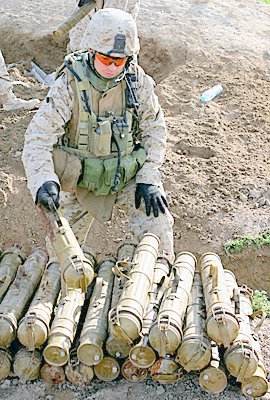
U.S. Marine Corps Sgt. Russel Cooley, assigned to Mobile Assault Platoon, 3rd Battalion, 5th Marine Regiment, stacks a cased 82-mm high explosive mortar during Operation Iron Fist in the Al Anbar Province, Iraq, Feb 25, 2006. Marines assigned to Company L, 3rd Battalion, 5th Marine Regiment, along with Iraqi Security Forces found two weapons caches during the operation. U.S. Marine Corps photo by Cpl. Mark Sixbey

U.S. Navy Petty Officer 1st Class Brian Edward, an explosive ordnance disposal specialist assigned to Mobile Unit 3, Detachment 9, 8th Engineer Support Battalion, counts a stack of 82-mm recoilless rifle rounds uncovered by U.S. Marines of Company L, 3rd Battalion, 5th Marine Regiment during Operation Iron Fist in the Al Anbar Province, Iraq, Feb. 25, 2006. U.S. Marine Corps photo by Cpl. Mark Sixbey

U.S. Marine Corps Cpl. Herbert Ackerman removes a 100-mm high explosive mortar round from a buried weapons cache in the Al Anbar Province, Iraq, during Operation Iron Fist, Feb. 25, 2006. Ackerman is a combat engineer assigned to 2nd Combat Engineer Battalion attached to Company L, 3rd Battalion, 5th Marine Regiment. During the operation, the company uncovered two weapons caches with the help of Iraqi Security Forces. U.S. Marine Corps photo by Cpl. Mark Sixbey

Iraqi army soldiers exit a U.S. Army CH-47 Chinook helicopter during Operation Swarmer in Brassfield-Mora, Iraq, March 16, 2006. Operation Swarmer is a combined air assault operation to clear the area northeast of Samarra of suspected insurgents. U.S. Navy photo by Petty Officer 3rd Class Shawn Hussong

U.S. Army UH-60 Black Hawk helicopters lift off from Forward Operating Base Remagen, Iraq, for Operation Swarmer on March 16, 2006. Soldiers from the Iraqi Army's 1st Brigade, 4th Division and the U.S. Army's 101st Airborne Division's 3rd Brigade Combat Team are taking part in the combined air assault operation to clear the area northeast of Samarra of suspected insurgents. Defense Dept. photo by U.S. Army Sgt. 1st Class Antony Joseph
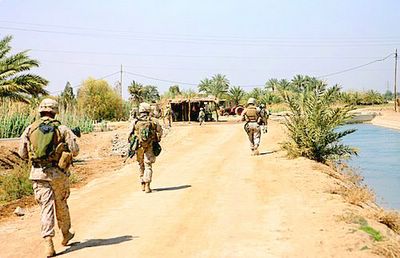
Marines from Company C, 1st Battalion, 1st Marine Regiment conduct security patrols in the area surrounding the Abu Ghraib prison. The Marines are learning their new area using a method of stopping, looking, seeing and smelling. The Marines use this tactic to check the area out for insurgent activities. U.S. Marine Corps photo by Cpl. William Skelton
Wednesday, March 29, 2006

A U.S. Army soldier pulls security from the back of a U.S. aircraft at Brassfield-Mora, Iraq, in support of Operation Swarmer March 16, 2006. Soldiers from the Iraqi Army's 1st Brigade, 4th Division and the U.S. Army's 101st Airborne Division's 3rd Brigade Combat Team are taking part in the combined air assault operation to clear the area northeast of Samarra of suspected insurgents. U.S. Navy photo by Petty Officer 3rd Class Shawn Hussong

From left, U.S. Army Lt. Col. Bruce Patrick, Multinational Division-Central South, Camp Echo, Diwaniyah, Iraq, poses with Danish army Capt. Benny Gottlieb Petersen and an Iraqi border police officer on Fort Karmashiya, Iraq, during an inspection of one of five Iraqi border police facilities on the border of Iraq and Iran, March 25, 2006. U.S. Air Force photo by Senior Airman Jason T. Bailey

A Polish army soldier mans a BKC machine gun on a Polish army vehicle during a convoy of coalition forces from the Iraqi border police office at Fort Khalied, Iraq, to Fort Karmashiya, Iraq, March 25, 2006. The coalition forces are convoying during an inspection of five Iraqi border police facilities on the border of Iraq and Iran. U.S. Air Force photo by Senior Airman Jason T. Bailey

A Polish army air assault soldier secures a perimeter near the helicopter pad at the Iraqi border police station on Fort Badrah, Iraq, while waiting for the arrival of Polish army Maj. Gen. Edward Gruszka, commander of Multinational Division - Central South, March 25, 2006. Gruszka and his staff are inspecting five forts on the border of Iraq and Iran. U.S. Air Force photo by Senior Airman Jason T. Bailey
Unmanned Predator Kills Three Terrorists; Relative Turns in Suspect
Unmanned Predator Kills Three Terrorists; Relative Turns in SuspectAmerican Forces Press Service
WASHINGTON, March 29, 2006 – An MQ-1B Predator unmanned aerial vehicle engaged three insurgents in the process of planting a homemade bomb along a road near Balad Air Base, Iraq, yesterday evening and launched an AGM-114 Hellfire missile against the group.
The Predator monitored the three terrorists for about a half hour while they used a pick ax to dig a hole in the road, placed an explosive round in the hole, and strung wires from the hole to a ditch on the side of the road. When it was clear the individuals were placing a bomb, the Predator launched the 100-pound Hellfire missile, killing all three insurgents.
"This is a prime example of how airpower is supporting the fight on the ground," Air Force Brig. Gen. Frank Gorenc, commander of the 332nd Air Expeditionary Wing at Balad, said. "We're able to provide a persistent view of the battlefield to commanders on the ground and, if called upon, put a weapon on a target within minutes."
Using joint Army and Air Force trend analysis and past incident reporting from the area, the Predator was assigned to monitor the general location where the insurgents were ultimately found. "Based on the information we had available, we had a pretty good idea there might be some activity in the area, and we were right," Gorenc said. "This strike should send a message to our enemies that we're watching you, and we will take action against you any time, day or night, if you continue to stand in the way of progress in Iraq."
In other news from Iraq, a relative of a suspected terrorist turned him over to Multinational Division Baghdad soldiers March 27, accusing him of conducting drive-by attacks against Iraqi army troops, officials reported today.
When soldiers from the 1st Battalion, 87th Infantry Regiment, responded to the relative's tip and went to the suspect's house, they found two AK-47 assault rifles, a 9 mm pistol, and body armor. The suspect was taken into custody for questioning.
Elsewhere, other tipsters told coalition forces and Iraqi army soldiers about two weapons caches on March 25. One cache contained 22 grenades, six grenade fuses and five blasting caps in southern Baghdad. U.S. soldiers from 1st Squadron, 10th Cavalry Regiment, 2nd Brigade Combat Team, 4th Infantry Division, and counterparts from the 2nd Battalion, 2nd Brigade, 8th Iraqi Army Division, found the cache.
A few hours later, another tip led the same soldiers to a large weapons cache containing 292 grenades, 350 machine gun rounds, 100 hand grenade fuses, two 120 mm artillery rounds, two 25-pound bags of artillery propellant, and repellant charges.
(Compiled from Multinational Force Iraq and U.S. Central Command Air Forces Forward news releases.)
WASHINGTON, March 29, 2006 – An MQ-1B Predator unmanned aerial vehicle engaged three insurgents in the process of planting a homemade bomb along a road near Balad Air Base, Iraq, yesterday evening and launched an AGM-114 Hellfire missile against the group.
The Predator monitored the three terrorists for about a half hour while they used a pick ax to dig a hole in the road, placed an explosive round in the hole, and strung wires from the hole to a ditch on the side of the road. When it was clear the individuals were placing a bomb, the Predator launched the 100-pound Hellfire missile, killing all three insurgents.
"This is a prime example of how airpower is supporting the fight on the ground," Air Force Brig. Gen. Frank Gorenc, commander of the 332nd Air Expeditionary Wing at Balad, said. "We're able to provide a persistent view of the battlefield to commanders on the ground and, if called upon, put a weapon on a target within minutes."
Using joint Army and Air Force trend analysis and past incident reporting from the area, the Predator was assigned to monitor the general location where the insurgents were ultimately found. "Based on the information we had available, we had a pretty good idea there might be some activity in the area, and we were right," Gorenc said. "This strike should send a message to our enemies that we're watching you, and we will take action against you any time, day or night, if you continue to stand in the way of progress in Iraq."
In other news from Iraq, a relative of a suspected terrorist turned him over to Multinational Division Baghdad soldiers March 27, accusing him of conducting drive-by attacks against Iraqi army troops, officials reported today.
When soldiers from the 1st Battalion, 87th Infantry Regiment, responded to the relative's tip and went to the suspect's house, they found two AK-47 assault rifles, a 9 mm pistol, and body armor. The suspect was taken into custody for questioning.
Elsewhere, other tipsters told coalition forces and Iraqi army soldiers about two weapons caches on March 25. One cache contained 22 grenades, six grenade fuses and five blasting caps in southern Baghdad. U.S. soldiers from 1st Squadron, 10th Cavalry Regiment, 2nd Brigade Combat Team, 4th Infantry Division, and counterparts from the 2nd Battalion, 2nd Brigade, 8th Iraqi Army Division, found the cache.
A few hours later, another tip led the same soldiers to a large weapons cache containing 292 grenades, 350 machine gun rounds, 100 hand grenade fuses, two 120 mm artillery rounds, two 25-pound bags of artillery propellant, and repellant charges.
(Compiled from Multinational Force Iraq and U.S. Central Command Air Forces Forward news releases.)
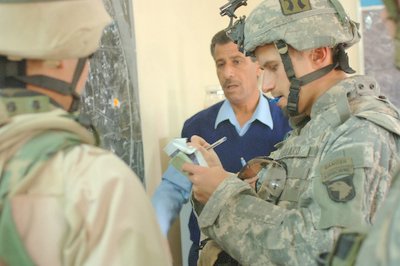
U.S. Army 2nd Lt. Patrick Vardaro (right) takes notes on the location of a bomb found by Iraqi police in Bayji, Iraq, on March 20, 2006. Vardaro is the platoon leader with 3rd Platoon, Bravo Company, 1st Battalion, 187th Infantry Regiment, 101st Airborne Division. DoD photo by Spc. Charles W. Gill, U.S. Army. (Released)


